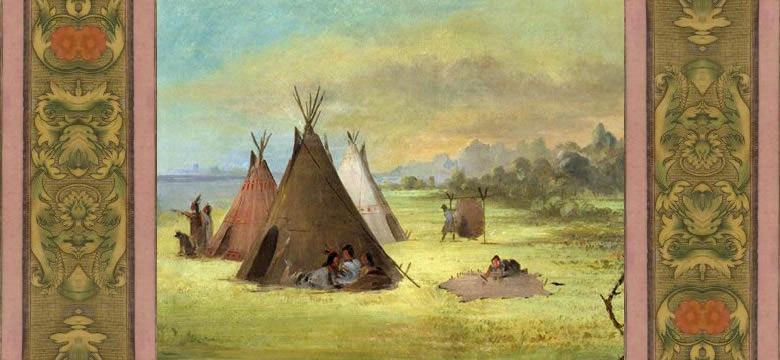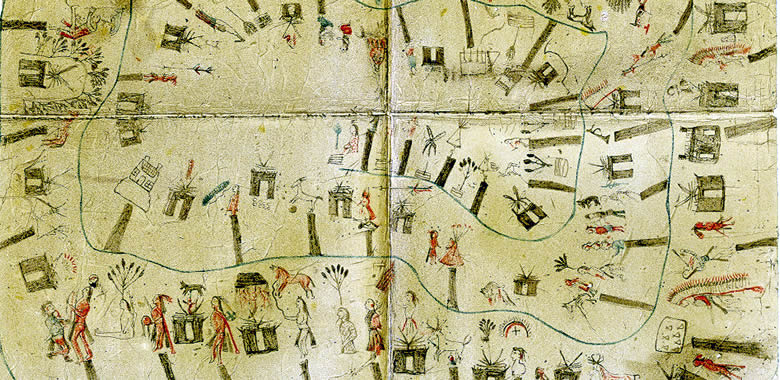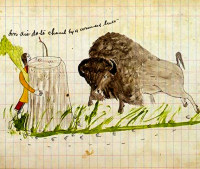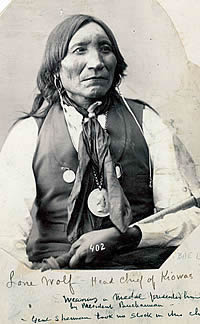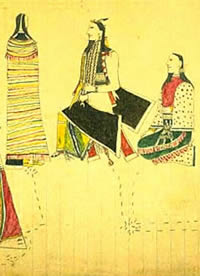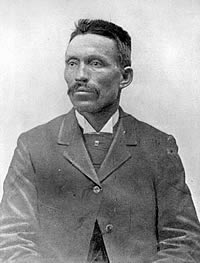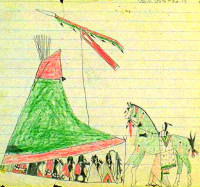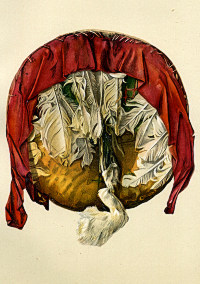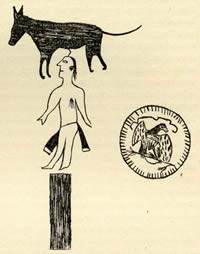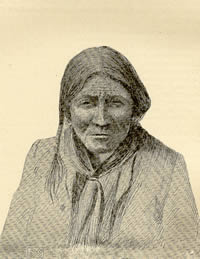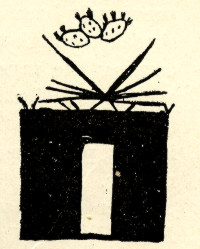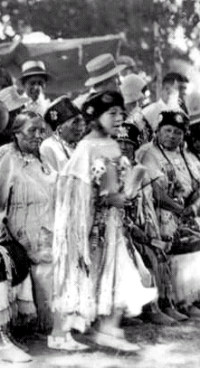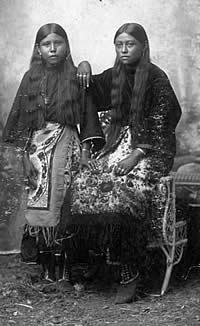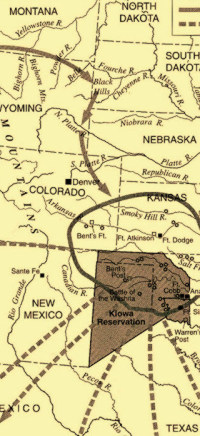
Migration of Kiowa peoples from the north in the 18th century to southern Plains in the 19th century. Shown are reservation boundary, raiding trails to south into Texas, New Mexico, and Mexico, and locations of annual Sun Dance, the major Kiowa religious ceremony. (Map adapted from Levy 2001.) |
The name "Kiowa" derives from the English spelling of "Ka'I gwu," meaning "principal
people." |
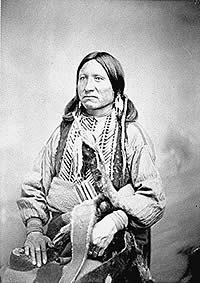
Kicking Bird (Tene'-angp6óte), a Kiowa chief and grandson of a Crow captive. Interviewed in the late 19th century, the chief told of the Kiowa's origins far to the north and of a time before there were horses to help move families from place to place. Photograph by William S. Soule, circa 1870. Original image in National Archives. |
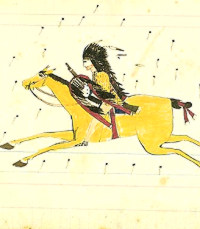
The introduction of the horse to North America changed the lifeways of Plains Indians, making buffalo hunting, moving camp, and engaging enemies easier. 1875 drawing of a Kiowa on horseback and symbols denoting fired musket balls by Koba, a Kiowa imprisoned at Fort Marion, Florida, following the Southern Plains Indian Wars. National Anthropological Archives, Smithsonian Institution INV 08547608. |
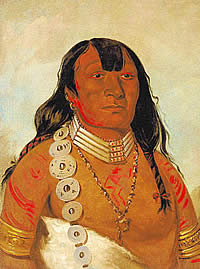
Teh-toot-sah, one of the Kiowa encountered by artist George Catlin, reportedly in an encampment along the Red River, Indian Territory, in the 1830s. The Kiowa was described by Catlin as the head chief of the Kioways (sic), " a very gentlemanly and high minded man, who treated the dragoons and officers with great kindness while in his country. His long hair, which was put up in several large clubs, and ornamented with a great many silver broaches, extended quite down to his knees." |
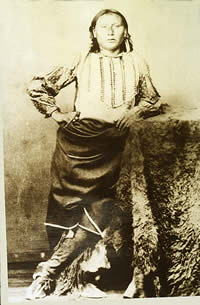
Big Tree, Kiowa leader involved in the attack at Howard's Well as well as in the Warren Wagon Train massacre in northwest Texas. |
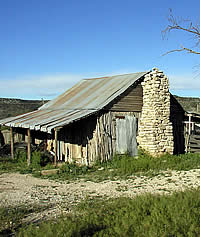
Howard's Well, a stage stop on the Southern Overland Mail route, was the target of repeated attacks by Indians throughout the 1860s and 1870s. The well-springs enclosed by limestone walls-was an important water source for travelers crossing the parched terrain. The jacal building shown above may date as early as the 1860s; a previous station on the site was destroyed by Comanches in 1861. Photo by Claude Hudspeth, TARL Archives. |
|
The Kiowa originally lived on the northern
Plains of Canada and moved south into the Southern and Rolling Plains
of Texas and Oklahoma in recent historical times. Prior to their
forced placement on a reservation in the 1870s they were, like other
Plains tribes, semi-nomadic, moving in relatively large groups and
frequently in the company of one or more tribes with whom they were
allied.
“Kiowa” derives from the English spelling of Ka’I
gwu, and in their language it means “principal people.” The
Kiowa language is part of the Kiowa-Tanoan language family. Tanoan
languages are those that were spoken in the Jemez, Piro, Tiwa, and
Tewa pueblos of New Mexico. Linguists who study the history of languages,
however, believe that Kiowa split from Tanoan branch over 3,000 years
ago. Thus, at some time in the past they moved to the far north or
the puebloan groups moved a considerable distance to the south prior
to the arrival of the Kiowa in the Southern Plains.
Kiowa Migration
By the early eighteenth century the Kiowa were living in the area
between the Platte and Kansas rivers well to the north of Texas.
From there they slowly moved further south, eventually becoming roaming
the lands north of the Canadian and Red rivers in Texas and Oklahoma.
In the late 19 th century, elders could still speak of their lands
far to the north. In the words of Chief Kicking Bird, in 1871:
The Kiowas, many years since, lived far to the north where it
was very cold most of the year—far beyond the country of
the Crows and the Sioux….They lived there, knowing nothing
of ponies, but used dogs to carry their burdens, to draw their
lodge poles, and remove all their fixtures from place to place.
He told a story of how the Kiowa were introduced to horses and
to the possibility of better lands to the south:
In the process of time one of their [Kiowa] men, in his travels,
went far to the southward, and after some years of roaming, was
taken prisoner by a band of Comanches. They took council to put
him to death, but one of their head men prevailed…on the
plea that they had never before seen anyone like him or any of
his people, and it might be that if they treated him well, he might
befriend any of their men who might fall in with his tribe….The
counsel of this chief prevailed, and [the Kiowa man] was fitted
out with a pony, saddle, and bridle and was sent home. On his return
[to the Kiowa people], his pony, saddle, and bridle were objects
of general admiration and envy….He told them that in this
country he had visited, the summer lasted nearly the whole year,
and the plains were well stocked not only with game, but large
herds of ponies such as he was riding.--Kiowa Chief Kicking Bird,
1871.
Like other oral history accounts, some of this may not be exactly
how events unfolded. However, we do know that among tribes on the
northern Plains in the 18 th century there existed relatively fierce
competition for buffalo and other resources. Some tribes may have
felt the need to venture further south where resources may not have
been as scarce. To transport their camps from place to place, dogs
were used as pack animals until horses became available from the
Spanish settlements to the south. Following buffalo herds into the
Southern and Rolling Plains of Oklahoma and Texas, the Kiowa established
a lasting bond with the Comanche and other tribes.
Over the ensuing decades, the Kiowa began to raid south into the
Plateaus and Canyonlands, along with their allies, the Comanche,
and other native people. By the late eighteenth century, they may have
been present in small numbers in the San Antonio area. One Spanish
document from 1784 lists the Sciaguas among the various native peoples
that were then present at Mission San Antonio de Valero. While the
name may be an aberration of one of the many groups from Coahuila,
its spelling appears to be a variant of the word Kiowa (Caigua or
Ka’I gua).
In the 19 th century, the Kiowa frequently traveled through the
Plateaus and Canyonlands going to and from Mexico. By the 1820s,
the Kiowa were raiding into South and Central Texas usually in consort
with the Comanche. As the nineteenth century progressed, the two
tribes were often encountered in the Southern and Rolling Plains
regions of Texas. Josiah Gregg’s 1844 Map of the Indian
Territory, Northern Texas and Mexico, showing the Greater Western
Plains depicts all of the Texas Panhandle as well as part of
Central Texas to be the territory of the Kiowa and their allies,
the Comanche.
George Catlin, an artist who traveled in the west in the 1830s and
painted portraits of the Indian tribes he met, encountered the Kiowa
while he was staying near modern Lawton, Oklahoma. He described them
as “much finer looking race of men than either the Comanchees
[sic] or Pawnees—[they] are tall and erect, with an easy and
graceful gait—with long hair….They have generally the
fine and Roman outline of the head.
In 1844, Texas Indian commissioner Robert Neighbors was told that,
while the Kiowa lived well to the north, when the leaves fell they
would be found in the vicinity of San Antonio. Neighbors reported
he found them between Pecan Bayou and the San Saba, the northern
portions of the Plateau and Canyonlands, in 1847 and 1848. He stated
that, with their allies, “they number (sic) 5,000 strong.” A
map in the National Archives shows the Kiowa and Comanche as the
principal tribes ranging from the Rio Grande to the Red River and
between the Pecos and Laredo, including the Plateau and Canyonlands.
During those years, the Kiowa were often part of the cohort in Comanche
raids. In addition to capturing horses, the Kiowa likely were gathering
peyote on these raids to the southwest. Peyote was important to the
Kiowa spiritual practice, and the plant could only be found far from
the Plains, in the desert areas to the southwest. The Rio Grande
River represents the northern-most limits of the plant’s growth.
Kiowa presence in the Plateaus and Canyonlands waned in the succeeding
decades. After 1860, the Kiowa rarely ventured into the region, remaining
to the north in the lands for which they are better known. Notable
exceptions occurred in 1860, 1872, and 1873. In 1860, a member of
a Kiowa band on its way to raid in Mexico was killed while attempting
to steal horses near the Pecos River. Then, in 1872, a Kiowa/Comanche
raiding party attacked a government wagon train at Howard Wells near
the Devil’s River, and another Kiowa/Comanche band traveled
to Mexico below Eagle Pass. On their return via the Devils River,
they encountered an Army scouting party that killed two of their
members. This battle may be immortalized in the rock artat
41VV327, a site located on a tributary of the Devil’s River. |
Other names for Kiowa:
Ka'i gwu, Caygua
Caigua, Kioway, Kinway
Ga'taqka, Cataka, Gatacka
Ka-ta-ka, Padouca
|
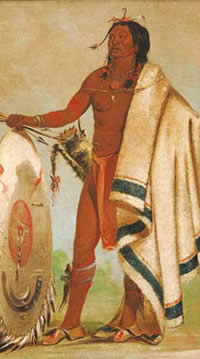
Kots-a-to-ah, or Smoked Shield, as painted by George
Catlin on the Red River of Texas circa 1830s. The frontier artist described
the Kiowa leader as "another of the extraordinary men of this tribe, near
seven feet in stature, and distinguished, not only as one of the greatest
warriors, but the swiftest on foot, in the nation. This man, it is said,
runs down a buffalo on foot, and slays it with his knife or his lance, as
he runs by its side!" |
The Kiowa are a "much finer looking race of
men than either the Comanchees [sic] or Pawnees-[they] are tall
and erect, with an easy and graceful gait-with long hair..They
have generally the fine and Roman outline of the head."-George
Catlin |
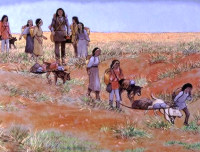
Moving camp. The Kiowa, like other Plains tribes, depended on dogs hitched to wooden sleds, called "travois," to move their camp equipment from place to place. Inset of painting by Nola Davis, courtesy Texas Parks and Wildlife Department. Original mural at Lubbock Lake Landmark, Lubbock. |
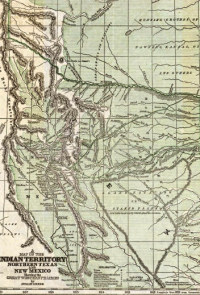
By 1844, the territory of the Kiowa was interspersed with that of their allies, the Comanche, and the two groups raided from the Texas Panhandle to the Gulf coast. Inset from Map of the Indian Territory, Northern Texas and Mexico, showing the Greater Western Plains by Josiah Gregg. Click to enlarge. |
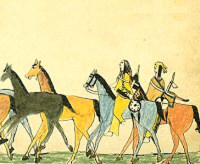
Kiowa herding horses captured during raid in Mexico? An 1875 drawing by Koba, one of the famed Fort Marion, Florida, prison artists. Click to see full image. |
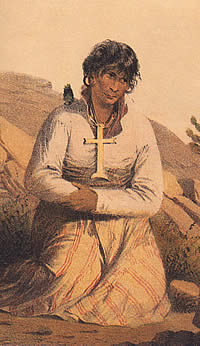
Toro-Mucho, chief of a band of Kioways. Woodcut made in 1854 during the United States and Mexican Boundary Survey. Courtesy Texas State Historical Association, in Emory 1987:88. |
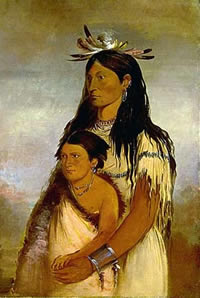
Wun-pan-to-mee (the white weasel), a girl; and Tunk-aht-oh-ye (the thunderer), a boy; who are brother and sister. As described by the artist, George Catlin, the two are Kioways (sic)who were purchased from the Osages, to be taken to their tribe by the dragoons (with whom Catlin was traveling in the 18302-1840s.). |
|
